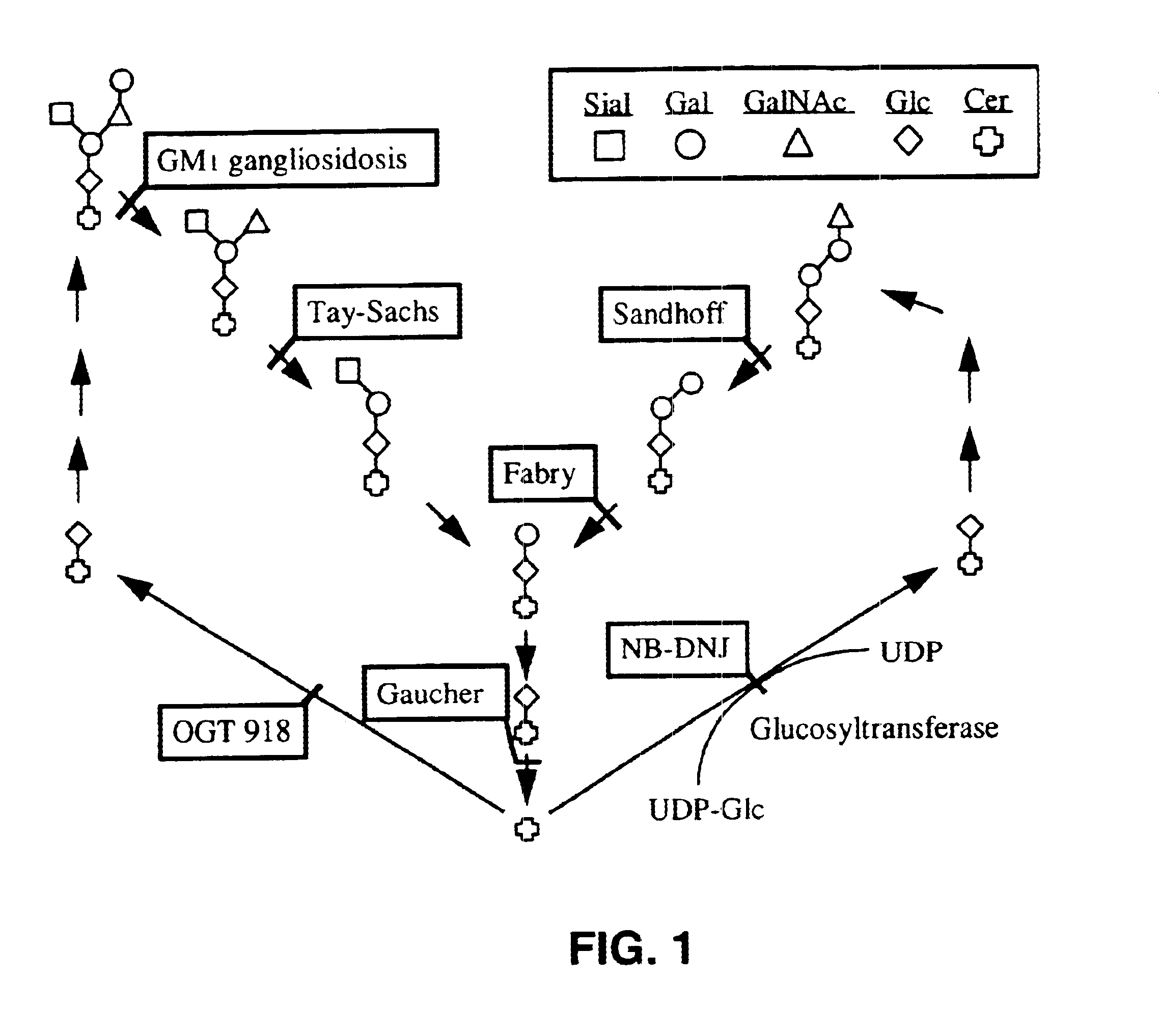Methods for therapeutic use of glucosylceramide synthesis inhibitors and composition thereof
a technology of glucosylceramide and synthesis inhibitor, which is applied in the direction of drug composition, peptide/protein ingredient, metabolic disorder, etc., can solve the problems of limiting the metabolism of administered glycolipids into other, perhaps unproductive forms, and glucosylceramide synthesis
- Summary
- Abstract
- Description
- Claims
- Application Information
AI Technical Summary
Benefits of technology
Problems solved by technology
Method used
Image
Examples
example 1
Inhibition of Clinical and Pathological Symptoms in a Feline Model of NPC
A domestic cat model of Niemann-Pick C has been described that demonstrates the disorder's characteristic liver storage of cholesterol, glucosylceramide, lactosylceramide and phospholipids, and neuronal storage of GM2 and GM3 gangliosides (Lowenthal et al (1990) Acta Neuropathol. (Berl) 81:189-197). A breeding colony for this animal model of NPC is being maintained to study the disease and its potential treatments (Brown et al (1996) J. Inherit Metab. Dis. 19:319-330). NPC cats exhibit clinical signs of the disease beginning around 2-3 months with ataxia and titubation, and progress to severe ataxia and death by around 10-12 months.
From seven feline NPC carrier litter mates, normal and NPC-affected male and female cats were selected for the study. The affected female and unaffected male began treatment with NB-DNJ at 1200 mg / kg / day. This administration level proved to be acutely hepatotoxic to the cats, so the ...
example 2
Histology and Lipid Analysis
The following sections highlight the histologic and lipid analysis findings for the study animals. As with humans, there is an increased expression of gangliosides in feline NPC neurons. Immunocytochemistry demonstrates numerous ganglioside immunoreactive neurons in the cerebral cortex and cerebellum. There is a corresponding increase in neuronal ganglioside level and histology changes seen in NPC humans. Importantly, NPC cats exhibit ectopic dendrite growth similar to that seen in human children with this disease (March et al (1997) Acta Neuropathol. 94:164-172).
Immunocytochemical studies with anti-GM2 ganglioside antibodies were used to probe for ganglioside expression in treated vs. untreated cats in a qualitative manner. Both normal cats, regardless of treatment status, did not display GM2 immunoreactivity in pyramidal cells of the cerebral cortex, Purkinje cells, or cells within the granular layer of the cerebellum. In the NPC cat that was not treate...
example 3
Inhibition of Clinical and Pathological Symptoms in a Mouse Model of NPC
Colonies of mutant mice expressing the NPC phenotype have been described (Pentchev et al., 1984, Miyawaki et al., 1986; Kitagawa, 1987), and has been validated by a number of criteria as an authentic model of the disease (Akaboshi et al., 1997). NPC mice display clinical signs of the disease around 6-8 weeks of age with mild intention tremor and ataxia. By 9 weeks, the mice exhibit severe ataxia, tremors and weight loss. Death results by 10-12 weeks.
The brains of NPC mice are grossly normal. However, microscopic examination reveals swollen somata, meganeurite formation and enlarged axon hillock regions of cortical pyramidal neurons. Meganeurites and neuritic tufts appear in amygdala neuron. White matter and Purkinje cells display axonal spheroids. Anti-ganglioside antibody staining shows increased GM2 levels primarily in laminae II / III and V pyramidal neurons, and astrocytes in layer I. GD2 levels are elevated i...
PUM
| Property | Measurement | Unit |
|---|---|---|
| body weight | aaaaa | aaaaa |
| weight | aaaaa | aaaaa |
| weight | aaaaa | aaaaa |
Abstract
Description
Claims
Application Information
 Login to View More
Login to View More - R&D
- Intellectual Property
- Life Sciences
- Materials
- Tech Scout
- Unparalleled Data Quality
- Higher Quality Content
- 60% Fewer Hallucinations
Browse by: Latest US Patents, China's latest patents, Technical Efficacy Thesaurus, Application Domain, Technology Topic, Popular Technical Reports.
© 2025 PatSnap. All rights reserved.Legal|Privacy policy|Modern Slavery Act Transparency Statement|Sitemap|About US| Contact US: help@patsnap.com

